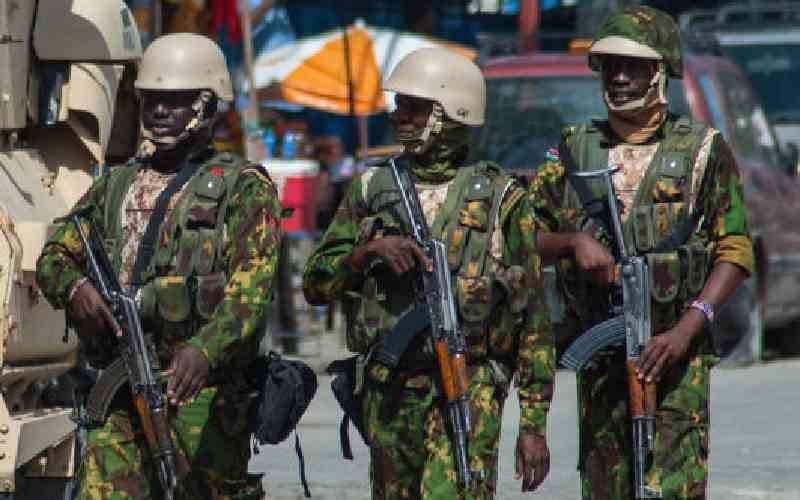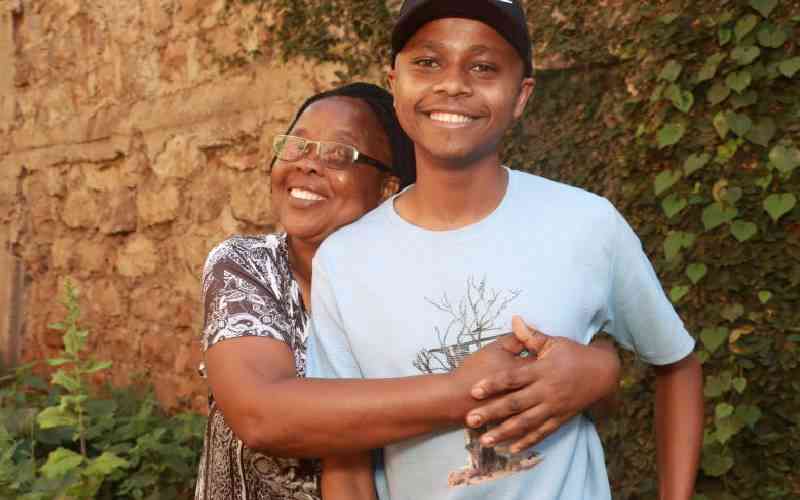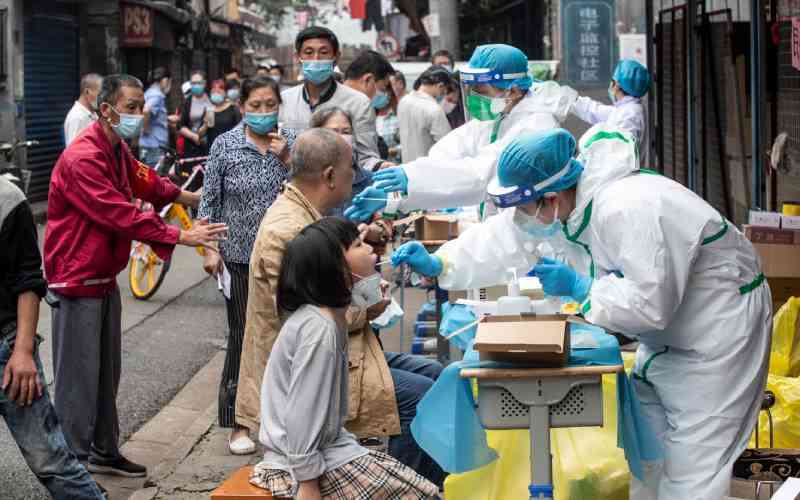
A male puppy playfully dashes in and out of a Maasai shuka spread across the magistrate’s table in a makeshift tent-turned-courtroom.
When he’s not dashing about, he’s trying to lick someone’s hands, nibble their heels, or roll over in the hope that someone will scratch his belly.
Oblivious to the serious proceedings taking place, he frolics in a setting at least eight kilometres deep within the lush, green forest cover of Acacia trees in Namanga.
Rain has been abundant here, leaving its mark in the form of deep trenches carved through the animals’ paths by the force of flowing water. The sandy soils make the ground particularly vulnerable to erosion.
Namanga is 163.4 kilometres from Nairobi, a journey that takes at least two hours and 43 minutes to reach this Kenya-Tanzania border town.
Our destination, however, is Oloiliai Village, nestled deep in the woods. To navigate there, we had to enlist a guide from the town.
On the Northeastern side of Namanga, a white cross stands out conspicuously against the greenery, like a lone sentinel. Our guide explains that it marks a well known to swallow anyone who dare to swim in its waters. “The devil lives there,” he says ominously. Finding the alleged clandestine lab, however, is a different story.
Digital pin
Secluded in the heart of a vast canopy of trees and thickets within Kajiado, it is well hidden from preying eyes.
If you are hoping Google will guide you to the place our guide refers to as ‘pale kwa mzee wa madawa’ (the medicine man’s place), rest assured it won’t.
We were lost, even with a digital pin plus the guide, a journalist based in Namanga. Fortunately, by asking several locals, we managed to get directions.
The “analogue pin” turned out to be Administration Police officers tasked with guarding the site. Locals advised us to follow the tyre tracks left by the AP Landcruiser on the muddy ground.
This led us to the premises, enclosed by iron sheet fencing.
There are two gates, roughly 100 metres apart. The outer perimeter is fenced with barbed wire and chain link while the inner fence is fortified with iron sheets and secured by a second gate. It is impossible to see inside or gain access unless the gate is deliberately opened for you.
We are told that the area of interest spans around 10 acres, though only a small portion, around a quarter, was used to set up the structures.
The iron sheets have gathered rust over time, which would later become a point of contention between Namanga Anti-Narcotics Officer Wycliff Otany and the defence team. He tells the court that he has been trained in narcotics in the United States and has been in the job for 16 years.
Be cautious
Our first stop is a tent-turned-court. If you are new to such settings, you might mistake it for a regular gathering, as we’re all sitting on plastic chairs, except for Magistrate Thuku, who seated on a cushioned wooden chair.
The lawyers and prosecutors were not dressed in their usual smart ties and suits. Instead, some wore jeans or khaki trousers with casual shirts.
Apart from the police officers in uniform, it is somewhat difficult to distinguish between suspects, lawyers and us journalists. The court session starts at around 11am, but with a warning from the magistrate that we must drink water before visiting the four structures.
There are four structures in total. The first one, which we were warned about, is alleged to be the crystal meth lab.The second structure is an open space, which Otany claims is a makeshift gym. Inside, there are two five litre bottles filled with pebbles and tied with ropes, improvised as weights.
Next, there is another structure with a 5,000-litre water tank and a Pyramid brand 7.5 KVA generator. Two pipes are connected to two giant tanks, with two large horn-like attachments.

Otany tells Magistrate Thuku that these are boilers, and the tank is used for water storage, used in cooling.
Then there are other three rooms. In the first one, Otany alleges that there were three mattresses. Outside, there is a single sandaland a measuring can with a whitish substance.
The officer, who is the first witness in the case, also says that they also collected a shaving machine and a toothbrush, which were sent for testing in Nairobi.
In the second room, presumably a store, there are blue jerrycans containing Phenyl Acetone, along with jerrycans of hydrochloric acid and some tanks labelled as containing highly flammable substances.
In the third room, there is a mini fridge, a cooker, and two solar batteries. Otany also mentions that he found a book and a mobile phone here, both of which were sent for forensic examination. He states that the caretaker, codenamed XYZ, had been instructed to burn both items.
Returning to the alleged clandestine lab, the officer first instructs us to open the room to allow air to circulate before he begins explaining what is inside.
According to him, there are unknown chemicals in the room, which had allegedly been used and had a pungent smell capable of harming someone. “As you can see, the iron sheets have corroded more than the others, indicating a chemical reaction. They weren’t like this when we first visited. If we knock on it, I’m sure it will come down,” he claims. The group revisits two other rooms, a toilet and a bathroom, sandwiched between the iron sheet walls.
Right next to them, a small garden draws the eye, where red peppers and green grams have thrived without cultivation. When we return to the alleged lab, a curious insect has made the place its home – a mother-of-all spider, approximately two to three centimetres in size. It is unmoved by our presence and has a greenish hue.
In the meantime, the officer also explains that there are ethanol jerrycans and some used chemicals in small cans, which we redact for security reasons. He also warns that we should be cautious of dangerous snakes inside the premises.
Otany tells the court that he received information about the place and visited it, along with other police officers, on September 12, 2024, at around 14:30 hrs. “I was in the company of the DCI Ololilai. There was an iron-sheet gated home, which was guarded. We entered through a small gate, and the caretaker was called,” he testifies.
Dangerous drug
The officer explains that they gained access through a small gate and were able to locate XYZ. He states that, following this, six people were arrested in connection with the alleged plot to produce the world’s most dangerous drug.
One suspect is still at large. The accused in court are Israel Alvarado Vera, Egwu Ogba Mba, a Nigerian, Ojukwu Awu, alias Pastor, and Betty Mukami Micheni. Their lawyers ask Otany to clarify whether only one building had gathered rust.
He confirms that, from the outside, it was clear that one room had rusted more than the others. After spending at least three hours in court, the session is interrupted by rain, forcing an adjournment with two applications pending.
The accused request the court to order the appointment of their own independent chemicals expert. The case continues.
 The Standard Group Plc is a multi-media organization with investments in media platforms spanning newspaper print
operations, television, radio broadcasting, digital and online services. The Standard Group is recognized as a
leading multi-media house in Kenya with a key influence in matters of national and international interest.
The Standard Group Plc is a multi-media organization with investments in media platforms spanning newspaper print
operations, television, radio broadcasting, digital and online services. The Standard Group is recognized as a
leading multi-media house in Kenya with a key influence in matters of national and international interest.











